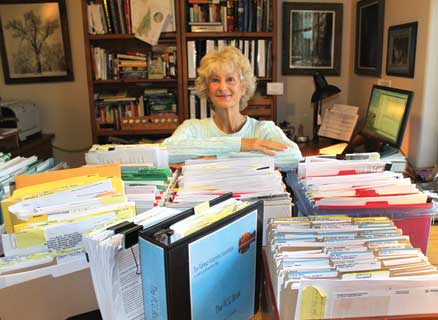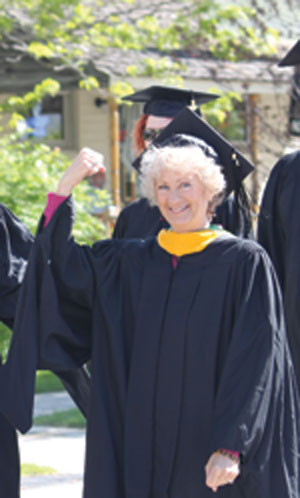The Story Behind the Story
I was a seasoned professional returning to college for a master’s degree in environmental studies. I was investing in my future, so I chose my educational institution carefully. I looked for a program that was designed around contemporary conservation ideas but that also embraced cultural traditions. I sought committed and creative professors and innovative coursework. And I desired a chance to better comprehend the scientific and philosophical concepts of ecology and conservation biology, and the principles of resource management. I was intrigued by the comprehensive curriculum offered by Green Mountain College in Poultney, Vermont—one of the nation’s pioneer environmental liberal arts colleges. It created immediate opportunities to transcend conventional graduate education by enabling students to apply their knowledge identifying and solving issues in their home bioregions. The thesis-based master’s program was distinctive and appealing.
Once enrolled, I was given the choice of a “traditional” thesis—try to develop a provocative research project that offers groundbreaking thinking—or an “applied project” thesis which, while not groundbreaking, might immediately benefit the community and region’s natural resources. I chose the latter. I wanted a project that would combine my new education with my lifetime of experiences and take advantage of my project management and organizational talent .
I reached out to a few trusted sources in my search for a thesis project. Thanks to a mutual friend, Marilyn Wood,I landed in a Kalispell café with a respected, long-time Flathead community educator, Lex Blood. His apprehension of taking on a project of this type with a graduate student melted quickly as he learned about my experience, interests and work ethic. He spoke to me about a group of educators with whom he was involved, and a project they were hoping to accomplish. I was interested in hearing more and meeting the people for whose work in their real jobs I had so much respect. Lex brought me to a meeting of the CORE Watershed Education Committee where eight dedicated professionals discussed some general Flathead resource education business and then “the project.” With the inclusion of other interested people, this group became the steering committee which met periodically throughout the project.
 The project discussed that day occupied my life for the following two years. The idea initially met with great skepticism outside the steering committee. Potential participants wanted to see the book and website materialize, but few thought it was doable in the timeframe. My thesis committee expressed concern for the massive scope of the project. Fortunately, I incorporated many hours of project research into my coursework. Throughout the project, Lex—who agreed to be my local thesis advisor—strongly supported my work, but also expressed concern over the timeframe we had set to complete it. The project changed and grew in complexity as such endeavors often do, but we never allowed it to waver from the committee’s original intent.
The project discussed that day occupied my life for the following two years. The idea initially met with great skepticism outside the steering committee. Potential participants wanted to see the book and website materialize, but few thought it was doable in the timeframe. My thesis committee expressed concern for the massive scope of the project. Fortunately, I incorporated many hours of project research into my coursework. Throughout the project, Lex—who agreed to be my local thesis advisor—strongly supported my work, but also expressed concern over the timeframe we had set to complete it. The project changed and grew in complexity as such endeavors often do, but we never allowed it to waver from the committee’s original intent.
It was indeed a breathtaking amount of work that required extensive research and endless hours of writing. But half of the effort was in procedures and communications. Research included extensive exploration, traditional excursions to college and public libraries, copious reading, field trips, and many conversations. After returning all of the “borrowed” reference books, I was left with a pile to organize of material just under five feet high. I developed a review process with electronic filing forms, and identified and engaged reviewers. The work included maintaining contact with more than 60 reviewers throughout the project, and balancing and incorporating their suggestions. I developed a process for the more than 50 individual submissions, and in a few cases conducted interviews and drafted the narratives. Each perspective required review cycles, photo management, design time, and numerous communications. These contributions would become the Watershed Perspectives that populate the book and that converge to give a voice to the Flathead Watershed. Funding the project was a slow, intricate, and sometimes complex task. There were extensive grant applications, presentations, and letters of rejection. But as the project came together and content began circulating across appropriate desks, organizations and individuals stepped in with their support.
communications. These contributions would become the Watershed Perspectives that populate the book and that converge to give a voice to the Flathead Watershed. Funding the project was a slow, intricate, and sometimes complex task. There were extensive grant applications, presentations, and letters of rejection. But as the project came together and content began circulating across appropriate desks, organizations and individuals stepped in with their support.
I appreciated the opportunity to work with the steering committee and the many people and organizations of the Flathead Watershed to bring this book and its companion website to the community. And, I did earn a Master of Science in Conservation Biology along the way.
Shortly after the publication of the first edition of this book, I was hired as Science and Education Director for the Whitefish Lake Institute (WLI), working with Executive Director Mike Koopal, one of the collaborators on the book. Since 2011, I have conducted aquatic research and managed the organization's science and education programs. Mike and I co-authored the Whitefish Water Resources Report: A Status of the Whitefish Lake Watershed (2015), the first compendium of data and information on our watershed. I was lead author on the Investigation of Septic Leachate to the Shoreline Area of Whitefish Lake, MT (2012), and I manage the Averill's Viking Creek Wetland Preserve—a 28.8 acre wetland preserve that WLI owns—and the Living Wetlands Interpretive Nature Trail within it. My role at WLI allows me to move from science to education, and from community collaboration to policy.
Editorial Note: Lori has also been an adjunct Instructor for Green Mountain College since 2011 where she teaches courses and advises thesis students. She is the recipient of the 2011 Outstanding Writer Award from the Montana Chapter of the American Fisheries Society for this book, and received the 2010 Partner of the Year Award from the Northwest Regional Resource Conservation & Development. Lori currently serves as a Supervisor on the Flathead Conservation District Board of Directors, is a technical facilitator for the City of Whitefish, and is a member of the Flathead Community of Research Educators (CORE) Watershed Education Committee. Her previous service includes Board of Directors for Sinapu (now part of WildEarth Guardians), including two years as Chair; Board member for the Grand County Builders Association; and Director of Ecology for the International Diving Society.
